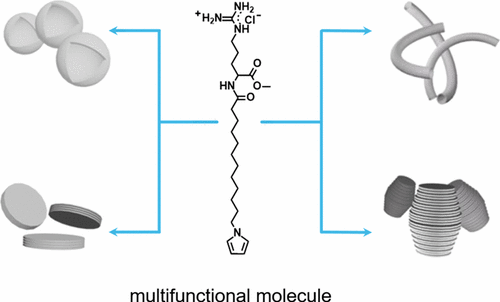当前位置:
X-MOL 学术
›
ACS Appl. Mater. Interfaces
›
论文详情
Our official English website, www.x-mol.net, welcomes your
feedback! (Note: you will need to create a separate account there.)
Guanidinium-Based Polymerizable Surfactant as a Multifunctional Molecule for Controlled Synthesis of Nanostructured Materials with Tunable Morphologies
ACS Applied Materials & Interfaces ( IF 8.3 ) Pub Date : 2017-05-12 00:00:00 , DOI: 10.1021/acsami.7b03970 Jingwei Ji 1 , Wei Zhu 1 , Jian Li 1 , Peng Wang 1 , Yun Liang 1 , Wanlin Zhang 1 , Xianpeng Yin 1 , Baozhen Wu 1 , Guangtao Li 1
ACS Applied Materials & Interfaces ( IF 8.3 ) Pub Date : 2017-05-12 00:00:00 , DOI: 10.1021/acsami.7b03970 Jingwei Ji 1 , Wei Zhu 1 , Jian Li 1 , Peng Wang 1 , Yun Liang 1 , Wanlin Zhang 1 , Xianpeng Yin 1 , Baozhen Wu 1 , Guangtao Li 1
Affiliation

|
Rationally and efficiently controlling the morphology of nanomaterials plays a crucial role in significantly enhancing their functional properties and expending their applications. In this work, a strategy for controlled synthesis of diverse nanostructured materials with tunable morphologies was developed using a guanidinium-based surfactant with a polymerizable pyrrole unit as a multifunctional molecule that can serve not only as a structure-directing agent for mesostucture formation but also as a monomer and carbon source. The unique self-assembly behavior of the guanidinium head group under different conditions allows the synthesized surfactants to form different aggregates and thus to produce silica nanomaterials with multiple morphologies (such as sphere, disk, fiber, and cocoon) in conjunction with sol–gel chemistry. Besides the mesostructured silicates, by further exploring the polymerization and carbonization features of pyrrole units that were densely packed in the formed silica nanochannels, diverse nanostructured materials such as mesostructured conducting polymers, carbon materials, and metal-nanoparticle (NP)-decorated forms could also be easily obtained in one-pot fashion for various applications, such as energy storage and catalysis. As a demonstration, carbon nanotubes and Pd-NP-doped hollow carbon spheres were fabricated, which exhibited good specific capacitance (101.7 F g–1) at the scan rates of 5 mV s–1 and excellent catalytic performance (100% conversion for three cycles) in the Suzuki C–C coupling reaction, respectively. All of the results indicate that our strategy may open a new avenue for efficiently accessing diverse nanostructured materials with tunable morphologies for wide applications.
中文翻译:

胍基可聚合表面活性剂作为多功能分子,用于可控制地合成具有可调形态的纳米结构材料
合理有效地控制纳米材料的形态在显着增强其功能特性和扩展其应用方面起着至关重要的作用。在这项工作中,使用具有可聚合吡咯单元的胍基表面活性剂作为多功能分子,开发了可控合成具有可调谐形态的多种纳米结构材料的策略,该分子不仅可以用作介晶结构的结构导向剂,而且还可以用作单体和碳源。胍头基团在不同条件下的独特自组装行为使合成的表面活性剂能够形成不同的聚集体,从而结合溶胶-凝胶化学反应生产具有多种形态(例如球形,圆盘状,纤维状和茧状)的二氧化硅纳米材料。除了介孔结构的硅酸盐外,通过进一步研究紧密地堆积在形成的二氧化硅纳米通道中的吡咯单元的聚合和碳化特征,多种介孔结构的材料,如介孔结构的导电聚合物,碳材料和金属-纳米粒子(NP)-修饰的形式,也可以容易以一锅方式获得各种应用,例如能量存储和催化。作为演示,制备了碳纳米管和掺杂Pd-NP的空心碳球,它们显示出良好的比电容(101.7 F g 金属纳米颗粒(NP)装饰的形式也可以很容易地以一锅方式获得,用于各种应用,例如能量存储和催化。作为演示,制备了碳纳米管和掺杂Pd-NP的空心碳球,它们显示出良好的比电容(101.7 F g 金属纳米颗粒(NP)装饰的形式也可以很容易地以一锅方式获得,用于各种应用,例如能量存储和催化。作为演示,制备了碳纳米管和掺杂Pd-NP的空心碳球,它们显示出良好的比电容(101.7 F g–1)的扫描速率为5 mV s –1,并且在Suzuki C–C偶联反应中分别具有出色的催化性能(三个循环100%的转化率)。所有的结果表明,我们的策略可能为有效地访问具有可调谐形态的各种纳米结构材料开辟新的途径,以用于广泛的应用。
更新日期:2017-05-23
中文翻译:

胍基可聚合表面活性剂作为多功能分子,用于可控制地合成具有可调形态的纳米结构材料
合理有效地控制纳米材料的形态在显着增强其功能特性和扩展其应用方面起着至关重要的作用。在这项工作中,使用具有可聚合吡咯单元的胍基表面活性剂作为多功能分子,开发了可控合成具有可调谐形态的多种纳米结构材料的策略,该分子不仅可以用作介晶结构的结构导向剂,而且还可以用作单体和碳源。胍头基团在不同条件下的独特自组装行为使合成的表面活性剂能够形成不同的聚集体,从而结合溶胶-凝胶化学反应生产具有多种形态(例如球形,圆盘状,纤维状和茧状)的二氧化硅纳米材料。除了介孔结构的硅酸盐外,通过进一步研究紧密地堆积在形成的二氧化硅纳米通道中的吡咯单元的聚合和碳化特征,多种介孔结构的材料,如介孔结构的导电聚合物,碳材料和金属-纳米粒子(NP)-修饰的形式,也可以容易以一锅方式获得各种应用,例如能量存储和催化。作为演示,制备了碳纳米管和掺杂Pd-NP的空心碳球,它们显示出良好的比电容(101.7 F g 金属纳米颗粒(NP)装饰的形式也可以很容易地以一锅方式获得,用于各种应用,例如能量存储和催化。作为演示,制备了碳纳米管和掺杂Pd-NP的空心碳球,它们显示出良好的比电容(101.7 F g 金属纳米颗粒(NP)装饰的形式也可以很容易地以一锅方式获得,用于各种应用,例如能量存储和催化。作为演示,制备了碳纳米管和掺杂Pd-NP的空心碳球,它们显示出良好的比电容(101.7 F g–1)的扫描速率为5 mV s –1,并且在Suzuki C–C偶联反应中分别具有出色的催化性能(三个循环100%的转化率)。所有的结果表明,我们的策略可能为有效地访问具有可调谐形态的各种纳米结构材料开辟新的途径,以用于广泛的应用。


















































 京公网安备 11010802027423号
京公网安备 11010802027423号